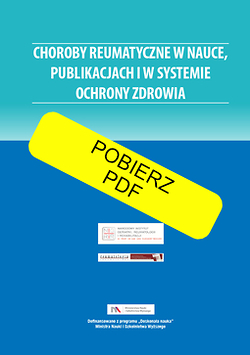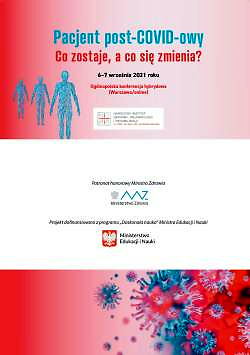|
4/2010
vol. 48
Original paper
Application of fluorescence spectroscopy in the amyloidosis diagnosis: a preliminary report
Monika Prochorec-Sobieszek
Reumatologia 2010; 48, 4: 230-236
Online publish date: 2010/09/21
Get citation
Introduction Amyloidosis comprises a heterogeneous group of diseases characterized by extracellular deposition of amorphous and insoluble proteinaceous substance called amyloid stainable with Congo red, characterized by green birefringence in polarized light and consisting of polypeptide chains of beta conformation. This pathogenic mechanism generates various clinical syndromes depending on the site and extent of organ involvement. Amyloid chains are built from a variety of normal or aberrant serum proteins, which reveal biochemical differences, what is the basis for distinguishing about 25 types of amyloid. The most common type of amyloid includes immunoglobulin light chains amyloid (AL), which is present in the primary amyloidosis or amyloidosis associated with plasma cell dyscrasias, transthyretin-related amyloid characteristic of senile amyloidosis (AS) and some forms of familial amyloidosis connected with about 80 mutations of the transthyretin coding gene (ATTR) as well as AA amyloid (reactive or post-inflammatory). The therapeutic approach in amyloidosis is bidirectional and consists of symptomatic treatment depending on improvement in the function of occupied organs, and if possible, causal treatment directed to decrease or eliminate the production of abnormal amyloid protein. Despite progress in treatment, prognosis in this disease is still poor and depends on the accompanying disease, amyloidosis type and the degree of organ failure. Early diagnosis of amyloidosis is essential for the further course of the disease, because patients with advanced amyloidosis are usually in poor condition, unable to undergo intensive causal therapy [1].
Patients with systemic amyloidosis are often diagnosed by a rheumatologist, because secondary AA amyloidosis may be a complication of chronic rheumatic diseases such as rheumatoid arthritis (RA), juvenile idiopathic arthritis, ankylosing spondylitis, psoriatic arthritis, and Behcet's syndrome [2-4]. AA amyloidosis is caused by deposition of amyloid fibrils, which are derived from the acute-phase reactant serum amyloid protein A (SAA). Nephropathy with proteinuria is a major clinical symptom, for which patients with rheumatoid arthritis should be evaluated routinely. The valuable methods of the diagnosis and monitoring of the disease comprise assessment of the concentration of protein SAA in serum and scintigraphy using the human serum P protein. In prevention and treatment of AA amyloidosis the drugs that inhibit the production of SAA are used [5].
Clinical data and laboratory tests can only raise the suspicion of amyloidosis, but diagnosis of amyloidosis is still based on the detection of deposits in tissues. In the case of suspicion of systemic amyloidosis a biopsy of the involved organ (i.e. kidney or heart) is unnecessary. A relatively simple and safe diagnostic test is the abdominal fat tissue biopsy or biopsy of rectal mucosa. The amyloid deposits are detectable by Congo red staining and must be examined under polarized light for the presence of apple-green birefringence. The type of amyloidosis is evaluated by immunohistochemical staining using monoclonal antibodies against the major amyloid proteins: P and A amyloid components, light chains, k and l immunoglobulin light chains as well as transthyretin. Amyloid fibrils may be evaluated in electron microscopy [6].
Fluorescence spectroscopy is an alternative diagnostic method already used in the diagnosis and monitoring of neoplasms [7, 8]. The advantages of these studies include their objectivity, short time of performance and the ability to detect very subtle changes in the sample. So far little attention in the literature has been paid to studies using fluorescence spectroscopy in the diagnosis of rheumatic diseases. In our earlier work concerning the application of fluorescence in medical diagnosis [9, 10] significant differences in the spectra of fluorescence were observed even in the most basic research performed in the field of fluorescence spectroscopy, simpler than those currently used in the diagnosis of neoplasms and Alzheimer's disease [11].
The aim of this study was to evaluate the usefulness of fluorescence spectroscopy studies in the diagnosis of AA amyloidosis, a complication of RA. Material and methods We examined 20 patients with RA (19 women, average age 56.5 years) with clinical suspicion of amyloidosis (proteinuric renal dysfunction in laboratory studies). Abdominal fat tissue specimens taken to establish the diagnosis were fixed in 10% formalin, routinely processed and embedded in paraffin wax. 2 µm thick sections were cut, stained with the Congo red and observed under polarization microscopy. In all cases, immunohistochemical studies were done using the EnVisionTM Detection system (DAKO) and the following monoclonal antibodies: amyloid A component, amyloid P component, transthyretin, k and l light chains (DAKO). Fluorescence spectroscopy was investigated in undyed tissue slices on slides tailored primary and dewaxed in xylene.
Measurements of fluorescence spectra of the samples were taken using spectrofluorimeter Hitachi F-2500. Scanning of the spectral distribution of intensity of fluorescence was performed at a rate of 1500 nm/min and spectral resolution of 2.5 nm. Since the samples were placed on glass slides that are not transparent to UV light, a special holder was built there for fluorescence excitation and detection of the front of the sample, i.e. without the plate. Excitation wavelength was falling on the surface of the sample at an angle of 60 degrees, while the fluorescence light was measured in a direction perpendicular to the sample surface. Such an experimental setup eliminated excitation light access to the channel detection, on the other hand it led to the most effective measurement of fluorescence intensity. For all tested samples, the measurements of fluorescence spectra for a range of wavelengths of light excitation were carried out. Results and discussion In 12 patients on the basis of histopathological and immunohistochemical examination of abdominal adipose tissue secondary AA amyloidosis was diagnosed. In 8 patients, despite clinical suspicion, amyloidosis was excluded (control group). In 9 patients with histopathologically confirmed AA amyloidosis, analysis of autofluorescence spectra showed differences between the slices containing amyloid deposits and healthy tissue. In three cases, the shape of the fluorescence spectra did not enable an unequivocal differential diagnosis.
The control tissue specimens were characterized by fluorescence spectra with a clear maximum, appearing at a wavelength within 350 nm (Fig. 1). In order to enhance the visibility of the shape of the fluorescence spectrum, the same spectrum is shown in Figures 2a-d. All of them have a similar course with the exception of the spectrum in Figure 2d, for which the initial value of the intensity ranged from 0.8. In the fluorescence spectra of tissue specimens with amyloid deposit two maxima were observed (Fig. 3 and Fig. 4a, 4c and 4d). The first maximum was evident at a wavelength in the vicinity of 300 nm, a second maximum at a wavelength within 350 nm. It was also the highest value of intensity for the whole spectrum – as was the case for the spectra obtained from control tissue slices. The spectra presented in Fig. 4b of the first maximum are not apparent, therefore, it was impossible to differentiate between tissues with amyloidosis and control tissues. Figures 5a-d show one selected fluorescence spectrum of tissue specimens and control tissue specimens had been diagnosed with amyloidosis. A characteristic feature in the spectrum of fluorescence of tissue slices with amyloidosis is the emergence of a second maximum in the fluorescence spectrum chart. Based on the presence of a second maximum, we propose distinguishing between tissue with amyloidosis and amyloid-free tissue. The studies were based on the phenomenon of autofluorescence. The fluorescence spectra were obtained only from the fluorescence signal of molecules, which spontaneously occurred in the examined tissue sections. Most studies for recording fluorescence spectra using spectrophotometers as well as the analysis of images obtained by fluorescence microscopy, preparations are introduced into additional dyes, which are used to obtain the fluorescence signal. In that case, the phenomenon of autofluorescence may cause the misstatement in the results [12]. Research carried out in the 1980s [13] was one of the first attempts to detect amyloid deposits. This method was also based on artificial introduction fluorophores and observation of changes in the intensity of their fluorescence. The study confirmed that the presence of amyloid significantly raised the intensity of the fluorescence signal. Unfortunately, not in all cases, the shape of fluorescence spectra allowed to differentiate between normal tissue and tissue containing amyloid deposits. Perhaps the greater sensitivity in this case would provide the time-resolved studies, in which fluorescence lifetime is measured. Change of the environment, which is the appearance of amyloid deposits in the cell, may affect the change in fluorescence lifetime. Currently, the use of fluorescence lifetime measurements for fluorophores artificially introduced into the sample can already detect amyloid deposits [14]. Another interesting alternative research based on the phenomenon of fluorescence may be the use of fluorescence microscopy along with the phenomenon of total internal reflection, which allows very precise observation of the thin film preparation. Recently published results of these studies indicate that use of the laser light can both prevent the formation of amyloid deposits and destroy them [15]. Conclusion The histopathological tissue examination remains the gold standard in the diagnosis of amyloidosis. Preliminary results indicate that the fluorescence spectrum analysis can be a diagnosis support method, but to assess its usefulness a larger group of patients as well as examination of other tissues (i.e. rectal or gingival mucosa) is needed. Acknowledgements We would like to thank Dr. hab. Jacek Fisz for emission spectra measurements.
References
1. Picken MM. Amyloidosis-where are we now and where are we heading? Arch Pathol Lab Med 2010; 134: 545-551.
2. Perfetto F, Moggi-Pignone A, Livi R, et al. Systemic amyloidosis: a challenge for the rheumatologist. Nat Rev Rheumatol. 2010; 6: 417-429.
3. Fornalska L, Lewandowski J, Hrycaj P. Opis przypadku – współistnienie ciężkiego reumatoidalnego zapalenia stawów i amyloidozy. Reumatologia 2009; 47: 385-388.
4. Chemperek E, Majdan M, Kurowska M, i wsp. Opis przypadku – wole jako manifestacja kliniczna wtórnej amyloidozy w przebiegu reumatoidalnego zapalenia stawów. Reumatologia 2006; 44: 374-377.
5. Lachmann HJ, Goodman HJ, Gilbertson JA, et al. Natural history and outcome in systemic AA amyloidosis. N Engl J Med 2007; 356: 2361-2371.
6. Prochorec-Sobieszek M, Bilińska Z, Grzybowski J, et al. Assessment of the inflammatory process by endomyocardial biopsy in patients with dilated cardiomyopathy based on histopathological and immunohistochemical methods. Kardiol Pol 2006; 64: 479-487.
7. Thomas TP, Myaing MT, Ye JY, et al. Detection and analysis of tumor fluorescence using a two-photon optical fiber probe. Biophys J 2004; 86: 3959-3965.
8. Chwirot BW, Chwirot S, Sypniewska N, et al. Fluorescence in situ detection of human cutaneous melanoma: study of diagnostic parameters of the method. J Invest Dermatol 2001; 117: 1449-1451.
9. Szczęsny W, Żuchowski P, Fisz JJ, et al. The ultrastructure of rectus sheath in patients with inguinal hernias and healthy controls-an evaluation by fluorescent and microspectrometric techniques. Hernia 2009; 13 suppl. 1: 64-65.
10. Jeka S, Żuchowski P, Fisz JJ, et al. Wykorzystanie zjawiska fluorescencji w diagnostyce chorób układowych tkanki łącznej. Pierwsze Krajowe Spotkanie Reumatologiczne, Łódź 9-10.10.2009.
11. Kwan AC, Duff K, Gouras GK, et al. Optical visualization of Alzheimer’s pathology via multiphoton-excited intrinsic fluorescence and second harmonic generation. Opt Express 2009; 17: 3679-3689.
12. Grateau G, Kyle RA, Skinner M. Amyloid and Amyloidosis. CRC Press, 2005.
13. Naiki H, Higuchi K, Hosokawa M, i wsp. Fluorometric determination of amyloid fibrils in vitro using the fluorescent dye, thioflavine T. Anal Biochem 1989; 177: 244-249.
14. Koh CJ, Lee M. Fluorescence lifetime imaging microscopy of amyloid aggregates. Bull Korean Chem Soc 2006; 27: 477-478.
15. Ozawa D, Yagi H, Ban T, et al. Laser-induced propagation and destruction of amyloid {beta} fibrils. J Biol Chem 2010; 285: 19660-19667.
Copyright: © 2010 Narodowy Instytut Geriatrii, Reumatologii i Rehabilitacji w Warszawie. This is an Open Access article distributed under the terms of the Creative Commons Attribution-NonCommercial-ShareAlike 4.0 International (CC BY-NC-SA 4.0) License (http://creativecommons.org/licenses/by-nc-sa/4.0/), allowing third parties to copy and redistribute the material in any medium or format and to remix, transform, and build upon the material, provided the original work is properly cited and states its license.
|
|

 POLSKI
POLSKI












